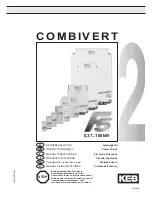
33
APPENDIX 3 Glossary
* Aspect Ratio:
It is the ratio of the width of the screen to the height. The two relevant digital TV
formats are 16:9 (wide screen) or 4:3 (the traditional screen ratio). 16:9 is more ergonomically suitable
for human's eye.
* Bandwidth:
Frequency range allows for carrying a certain radio signal. The speed of data
transmission depends on the available bandwidth of the transmission channel.
* Coaxial Cable:
A type of cable used to transmit high frequency signals e.g. from the VHF/UHF
antenna to the terrestrial Digital TV receiver.
* Composite Video:
There are three elements of the video system: First - the " active video" which
means the picture to be displayed on the screen and its associated colors. Second - the " sync" decides
where to place each pixel on the screen. Third - the " blanking" tells the display when to turn off the
electron beam so no retrace across the screen. These three elements combined together is called "
composite video" when connecting to a display through connectors.
* ATSC:
Abbreviation for "Advanced Television System Committee". The Advanced Television Systems
Committee, Inc. (ATSC), is an international, non-profit membership organization developing voluntary
standards for the entire spectrum of advanced television systems. They stipulate the standard for
terrestrial Digital TV broadcast which is also called ATSC.
* EPG:
Abbreviation for "Electronic Program Guide". A software that enable viewers to navigate through
the large number of channels offered by digital TV broadcaster and select the desired services.
* Frequency:
The property of a signal which is measured in cycles per second (=Hertz).
* Letterbox:
The picture with aspect ratio 16:9 in a 4:3 TV screen with blank lines on top and bottom.
It is the means to watch a wide screen TV program on a 4:3 TV screen.
* Megahertz (MHz):
Millions of cycles per second, which describes frequencies of radio wave or
electric current.
* OSD
: Abbreviation of "On Screen Display", used in digital set top box. OSD is comprised of a main
menu and many submenus with lots of options of functions inside.
* NTSC:
Stands for "National Television System Committee”, the U.S. video standard which includes the
image format of 4: 3, 525 horizontal lines (only 480 lines active among them, 60 Hz and a total 6 MHz
channel width.
* PID:
Stands for "Packet Identifier". It is a code used for identifying video, audio PCR and other
elements that form a particular service in the transport stream.
* RF Channel:
Radiated Frequency Channel, one RF channel may carry 4 to 6 sub-channels
2-1,2-2,2-3.etc.
* S-Video (also called Y/C):
The standard for the way a video signal is carried on the cable. Y
represents brightness and C represents color. S-Video cables have separate wires for the color and
brightness so it offers a better picture quality than the composite video.
* VHF:
Stands for "Very High Frequency", starts from 30 to 300 MHz corresponding to
channels 2-13,including Bands I, II and III.
*
UHF:
Stands for "Ultra High Frequency", starts from 300 to 3000 MHz corresponding to channels 14-69,
including Bands IV and V.
*
Y/Pb/Pr:
Component Video Output. It is better than S-Video and Composite Video output in terms of
picture quality. Y/Pb/Pr is the standard HDTV connector.
Summary of Contents for RC-1010
Page 34: ...34 APENDIX 4 Technical Specifications ...
Page 36: ...36 ...




































